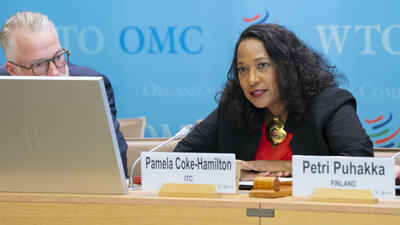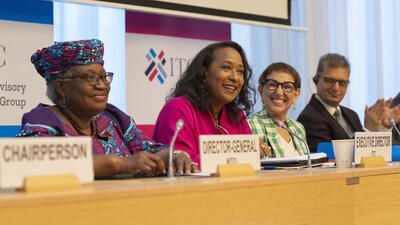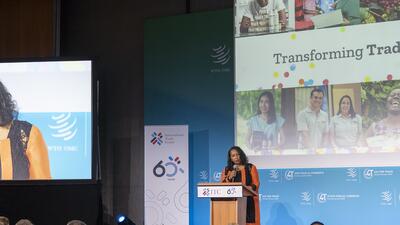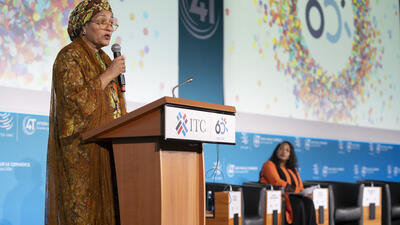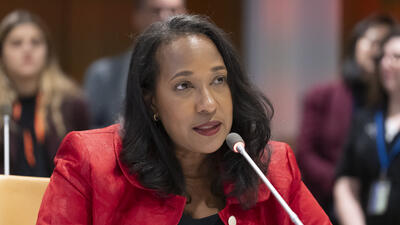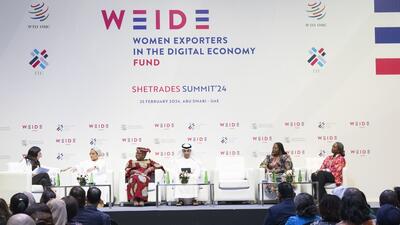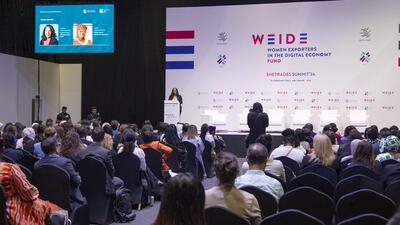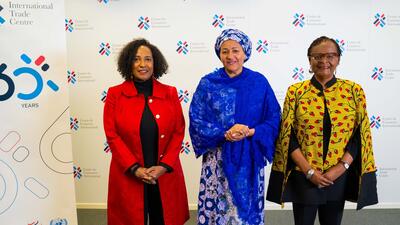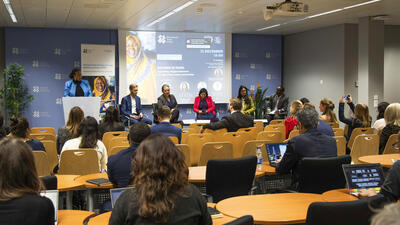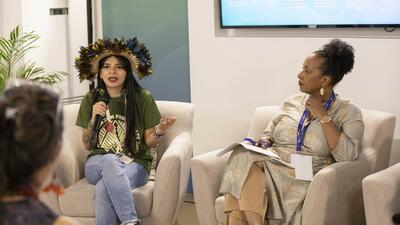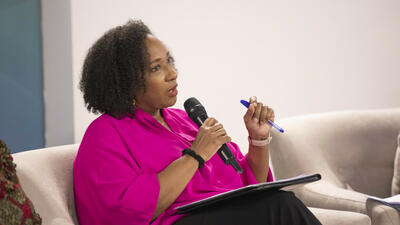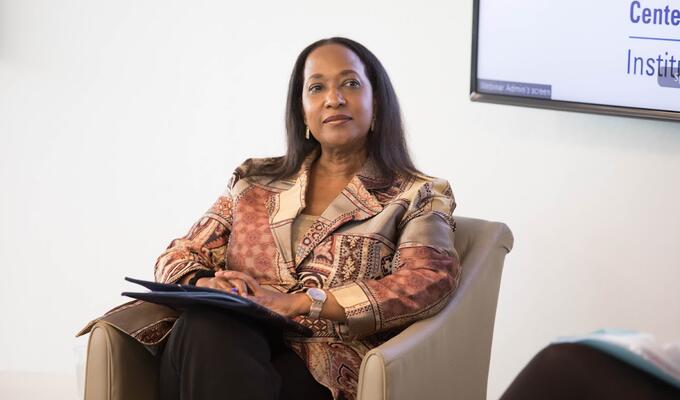
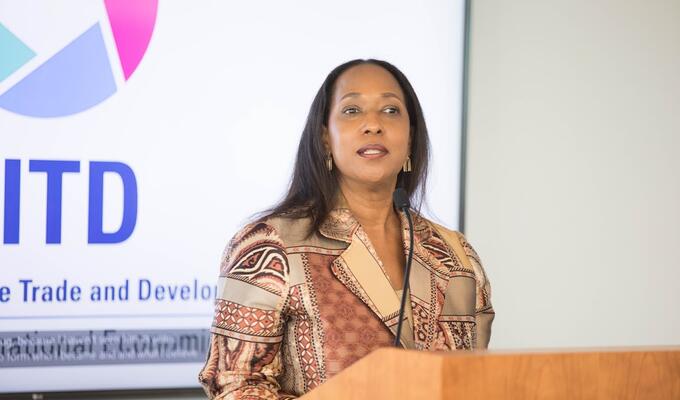
Launch of Georgetown University – Center on Inclusive Trade and Development
Good afternoon everybody. First off, I’d like to thank Jennifer and Katrin for the invitation to speak today as part of the Global Trade Academy.
Georgetown is my alma mater. Google tells me that “alma mater” means “nourishing mother”. Georgetown certainly did nourish me, at a critical time.
I was a young Jamaican foreign service offer, fresh off a posting to Geneva in the closing days of the Uruguay Round. I was just beginning to understand how to assume my space as a woman in the very male arena of trade policy. As the representative of a small island developing state in a club of big, rich countries that set the trade agenda.
So today’s theme of inclusive trade, and the mission of the Centre that Jennifer and Katrin are launching, couldn’t be any closer to my heart.
I’ve been asked to give a ten to fifteen minute opening talk on inclusive trade, while sparing you a blizzard of statistics, or burying you in UN jargon.
Let me start then by telling you a story.
Like most heads of UN agencies, I get a lot of invites for the panels, lunches and diplomatic receptions that are the lifeblood of any diplomatic town like Geneva. Last week, I decided to ditch these invites and head to Central America.
First to Guatemala City, then in a car for three hours, past live volcanoes and miles of beautiful countryside, to a place called Ciudad Pedro de Alvarado, right on the border with El Salvador.
My organisation, the International Trade Centre or ITC, has a USAID-funded project there. There is a community of small businesses that has grown up around the border post at the edge of the city.
When the government, in the name of promoting better trade facilitation, decided that the border post needed to be moved, the community pushed back. Their livelihoods were built around the miles-long lines trucks waiting to clear the border formalities. Those livelihoods, they felt, were now at risk.
In partnership with the municipal authorities, we helped to re-train these small business owners and entrepreneurs to do new things. It was a classic case of trade adjustment assistance but it a remote, resource-constrained community.
I spent a morning in a restaurant by the roadside listening to their stories. It was very hot, there was no AC and the truck horns blared in the background. But the testimonies I heard that morning, I won’t forget for a long time.
I’m telling you this story because it encapsulates what I think inclusive trade is all about. At its core, it’s about ensuring that trade works for everyone – especially developing countries, for vulnerable communities, minorities, women, and small businesses.
But in a wider sense, it’s about a certain kind of recognition.
First, it’s a recognition that just because trade laws and regulations are neutral on the page – and we trade lawyers build entire careers policing that neutrality – their outcomes, all too often, are not neutral.
That lack of neutrality matters. The discussion we’re having today is just the sound of words on a page meeting economic reality.
Second, it’s a recognition that creating inclusive trade is hard. I really want to emphasise this point. During the last few months, I’ve been pushing my own staff to really stretch our offer on the core elements of inclusive trade: on the green economy, gender, youth and digital connectivity.
I deliberately labelled that internal exercise as a “moonshot”. It brings to mind the moment that JFK said that America had chosen to go to the Moon in a decade not because it was easy but because it was hard.
Inclusive trade is not something fuzzy or nice-to-have. Well designed and properly funded, it can be as crunchy, impactful and results-driven as anything else we do in trade policy.
I believe that inclusivity is the trade moonshot of our time. My parents’ generation created the basic structures of trade. Me and my peers fleshed out those ideas into the multilateral system we use today. The challenge of the next generation of trade professionals is to spread the benefits as widely and evenly as possibly.
Third, it’s a recognition that inclusivity really matters in the crazy world we are living in now.
It’s all too easy, in diplomatic and very political towns like Geneva or Washington, to focus on the handful of big players. To think that their struggles alone define the long term stability and legitimacy of the global trading system.
That view doesn’t make much sense to me. And why should it:
- When 90% of the world’s businesses and more than half of global employment are in micro, small and medium-sized firms.
- When, right now, Africa’s population under 35 is almost a billion people and that number will grow nearly two hundred percent by the end of this century.
- When advancing gender equality could add an estimated 12 trillion US dollars to global GDP, but women entrepreneurs run less than one third of the world’s small businesses.
Every great endeavour, every great moonshot, begins with a moment of recognition and I feel we are at one of those moments with inclusive trade.
And those three moments of recognition build up to probably the most important recognition of all: that we need to revisit the foundations of the trading system we’ve built up.
A lot of countries are taking long, hard looks at the trade agreements they signed – even the ones they enthusiastically pushed – and asking themselves the classic Latin phrase: Cui bono? Who benefits?
For those of you that might still be skeptical that inclusivity can be transformational, let me give you a few examples of what I think inclusive “moonshots” can look like. Let me throw down five challenges.
I’ll start with an area of trade that’s about as far from sexy as possible: public procurement. The trade policy details of procurement aren’t exactly ready for Netflix, but the numbers are staggering – it’s an 11 trillion US dollar market.
And the lower down the economic ladder you go, the higher the share of the economy – public procurement accounts for up to 40% of GDP in some least developed countries.
But only 1% of this public procurement pie goes to women owned businesses. So, challenge number one: can you imagine if we could change that – even by just a few percentage points?
Let me give you another example I feel particularly strongly about: cobalt in the Congo. Here we have a situation where nearly two thirds of the raw material lying at the heart of every national net-zero strategy is mined in one country. Mined in what are often appalling, exploitative conditions.
I recognise there are important steps being take right now. My own organisation is helping the EU and other countries ensure that measures like supply chain due diligence doesn’t mean that markets suddenly slam shut for developing country exporters. That developing countries aren’t left to pay the costs for what is, ultimately, a good thing.
But the situation continues while climate ambitions keep ramping up. So, challenge number two: can we reach net zero on the back of a global supply chain in cobalt that we can truly, honestly call sustainable and inclusive?
Another area is helping small businesses, especially in developing countries, make the green transition.
We know that 100 or so large firms account for nearly three quarters of greenhouse gas emissions. But how will millions upon millions of small businesses around the world make the green transition?
The ones who aren’t represented in forums like COP, who don’t have public affairs reps and easy access to credit? The small firms that see sustainability as only bringing new costs and risks, not new opportunities?
So challenge number three: can we make going green the default business and trade reality?
How about the digital revolution? Late last year, I was in Nigeria, meeting with the beneficiaries of our flagship women’s economic empowerment initiative called SheTrades.
I was amazed to hear that many of these women entrepreneurs – thanks to the training we offered in branding, digital marketing and e-commerce sales – were able to not just survive during the pandemic but actually increase their sales.
So challenge number four: how can we ensure that all businesses and traders can make the digital leap we all made during the pandemic, not just the ones who can afford an unlimited data package and reliable broadband?
And one last area: consultation and dialogue. In the nearly sixty years that the ITC has been in business, we’ve gotten a lot of requests from governments to help them engage a wider constituency in trade policymaking.
It’s a recognition that if you’re aiming for an inclusive outcome, you have to start with an inclusive process.
The stakes, again, are enormous. Take the African Continental Free Trade area as one example. Currently, intra-African trade is less than one-fifth of Africa’s total trade. Under the AfCFTA, this is meant to increase to one-half. All this, in a total African market of 2.5 trillion US dollars.
So the fifth and final challenge: how can we ensure that processes like the AfCFTA reflect the interests and aspirations of small businesses, women entrepreneurs and young people in Africa?
There you have it. Three moments of recognition, five challenges, one moonshot.
Those of you completing the Global Trade Academy will be going out into the world as shapers of policy. As foot soldiers in the battle to make trade more inclusive.
So in the spirit of this new Center, let me pose the biggest challenge of all. Ask yourself the hard question – is what I’m doing helping more people to benefit from trade?
Am I looking beyond the statistics of trade facilitation and customs formalities and reaching out to communities like Ciudad Pedro de Alvarado –
Am I cutting through the diplomatic blah blah blah and really tackling the big, daunting and complex inequalities at the heart of global trade –
Am I putting research, political capital and money into the issues facing the bottom of the pyramid –
If your answer is yes, then you’re not just putting icing on the cake. You’re assuring the future of the system from the ground up. You’re making the moonshot.
Not because it’s easy, but precisely because it’s hard.
Thank you.




